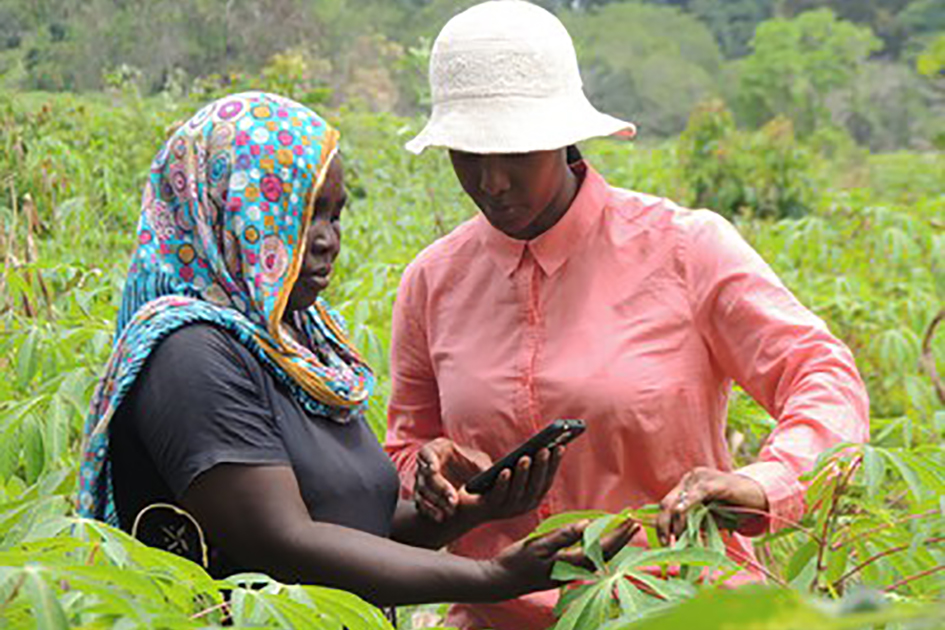
Our food and agriculture systems face profound challenges in the 21st century.
Consumers need more nutritious food that is affordable and safe; producers seek innovation to help them beat climate change and natural resource constraints; and the entire agri-food value chain must rapidly adopt new practices and tools that contribute to a healthy sustainable world.
Due to agriculture’s dependence on limited resources like water and land, it may be unique in its reliance on productivity and innovation to meet the rapidly growing demand of consumers by 2050.1 Agri-food innovation systems rely heavily on public agricultural research and development (R&D) and extension systems as well as regulatory frameworks that incentivize risk-taking innovation and investment.
Such agricultural R&D investments require long gestation periods of more than a decade to realize the full benefits that these investments generate. Over time, they pay large dividends, including higher profits for farmers, more abundant food supply at lower cost for consumers, and more opportunities and a higher quality of life in rural communities.
Yet, investments in public research in agriculture are not keeping up with the need. Without significant increases in R&D investment and partnerships, food and agriculture systems will fall short of a vision for a healthier, more sustainable world.
This chapter is a call to action to reverse the decline in public agriculture research, development and extension we face today.

Public R&D Sparks Innovation
Agricultural R&D along with extension programs are essential public goods and the principal drivers of Total Factor Productivity (TFP) growth. Public sector R&D and extension programs deliver innovation and information to agricultural producers. They provide access to proven techniques such as conservation agriculture and animal care practices to improve the sustainability and resilience of their operations.
While farmers innovate on their farms, experimenting with practices that can boost their own production, individually they do not have the capacity to conduct long-term research and development activities.
Public R&D provides foundational results that the private sector can further develop to improve specific crops, livestock, machinery or food manufacturing industries. R&D and extension services help producers control costs, reduce loss and waste and become resilient to weather challenges and climate change while conserving natural resources.
Countries that build national agricultural research systems (NARS) capable of producing a steady stream of innovations suitable for local farming systems have generally achieved higher growth rates in agricultural productivity than countries that do not make these investments.
Low-income countries must prioritize and increase investments, as their R&D spending remains much lower than others as a percentage of their agricultural GDP, a common measure of the commitment to productivity and agricultural innovation. Higher income countries must maintain a commitment to ongoing agricultural R&D to keep pace with ever-evolving challenges faced by their producers and consumers.
Troublesome Trends in U.S. Public Agricultural R&D
Historically, public funding of agriculture research has been strong and has generated robust TFP growth rates in the United States and other developed countries. These investments have also helped disseminate improved knowledge and technology, conservation practices and higher profitability for producers across additional regions.
Trends for agricultural R&D expenditures among selected countries show that China and India have boosted their commitments in the past decade to research, while expenditures in Brazil and countries in Western Europe have plateaued (Figure 1).
Given its long history as a leading investor in agricultural R&D, and particularly in light of the many challenges faced by U.S. farmers, fishers and ranchers as well as consumers, the U.S. government must now recommit its support and increase its investments in this critical area.
Understanding and mitigating the impact of climate change, preventing livestock diseases, improving water access and water quality, fighting pests in the crop, horticulture and forest industries, and promoting food safety and good nutrition will all require that the U.S. invest more in agricultural R&D and sustain those higher funding levels over the next 30 years to meet the challenge of ensuring global food security through 2050.
U.S. federally-funded national research programs continue to focus on basic issues of national level importance related to crop and livestock production and protection, human nutrition and food safety, rural development and natural resource management and conservation.
Federal research addresses higher risk and long-term issues, such as unlocking plant and animal genomes, as well as basic research not addressed by the private sector.
In addition to the government’s own agricultural R&D programs, the U.S. also funds external research in partnership with land-grant and other universities at the state and local level that is focused on regional or local needs in environment, human health and agriculture systems.
Figure 2

U.S. public agricultural R&D expenditures grew at least 2.6 percent annually in real terms in the years following World War II and this growth continued at a strong pace until levelling off in the early 1980s. In 2000, the rate of growth in public investment began to slacken, and it has declined 6 percent since then.
For high-income countries, the growth rate in spending for public agricultural R&D averaged four percent annually between 1960 and 1990. Between 1990 and 2009, the growth rate declined to just 1.3 percent annually, and then actually began to contract between 2009 and 2013, declining on average 1.5 percent annually (Figure 2).
Meanwhile, private sources of funding for R&D in agriculture production and food manufacturing picked up pace after 2000. However, research by the private sector does not replace basic foundational research by the public sector; rather, it focuses primarily on taking results from public sector research to the next level and creating marketable products for growers and consumers.
Private-sector research funding is subject to greater volatility and may fluctuate during the more challenging stages in agricultural business cycles, when it may be needed most.
Leveraging Research to Revolutionize Agri-Food Systems
Low-income countries have yet to attract significant levels of private-sector research funds, and a range of commodities (roots and tubers, tree crops, fish and small ruminants) lack investment.
The private sector brings significant resources in terms of investment and talent to the global agricultural research endeavor. Between 1990 and 2014, private spending on agricultural R&D tripled, from $5.14 billion to $15.61 billion (or doubled in constant PPP$).4 In high-income countries, the private-sector research investment constitutes a large portion of total agricultural research funding.
Many low-income countries, however, lack the public policy environment to attract such investment, such as a lack of intellectual property rights protection, adverse regulatory frameworks and poor marketing infrastructure for inputs such as seeds and machinery.
Africa’s Research Investment Gap
After the food price crisis of 2007 and 2008, many countries renewed their commitments to put agriculture, and particularly agricultural R&D, at the center of their policy agendas.

In many African nations, national agricultural research systems are highly dependent on funding from donors and development banks — funding that has been less predictable during the past decade. These countries must now mobilize new sources of funding to fill the research investment gap and build national research and extension systems to boost productivity in agriculture.
After stagnating during the 1990s, Africa’s agricultural research spending—excluding the private for-profit sector—increased considerably during 2000–2014, from $1.7 to $2.5 billion in 2011 PPP prices. But three countries accounted for nearly half of the investments made in 2014: Nigeria ($434 million), South Africa ($417 million), and Kenya ($274 million). Ethiopia, Ghana, Tanzania, and Uganda each also spent more than $100 million in 2014.
In contrast, 12 of the 40 countries for which data were available spent less than $10 million on agricultural research, and most of these are in West and Central Africa. Ethiopia, Ghana, Nigeria, South Africa, and Uganda drove about three-quarters of the $800 million growth in agricultural research spending during 2000–2014.2
The African Union’s New Partnership for Africa’s Development (NEPAD) and the United Nations (UN) are encouraging governments to allocate at least one percent of agricultural gross domestic product (AgGDP) to public agricultural R&D, a generally recognized investment level to sustain and build agricultural productivity. Overall investment levels in most countries are still well below those required, with only Mauritius, Namibia, Botswana, South Africa, Zimbabwe, Senegal and Burkina Faso exceeding the one percent of AgGDP target.3

Multi-Stakeholder Partnerships Help Fill the Research Gap
The international community established key research centers in the latter half of the twentieth-century to help developing countries improve crops such as wheat, rice and maize. CGIAR (formerly the Consultative Group for International Agricultural Research) is today a global research partnership with 15 centers (the CGIAR Consortium of International Agricultural Research Centers) spread around the globe.
CGIAR operates in partnership with national and regional agricultural research institutes, civil society organizations, academia, and the private sector and has expanded its research portfolio to include cassava, chickpea, sorghum, potato, millet and other food crops, as well as livestock, farming systems, the conservation of genetic resources, plant nutrition, water management, policy research, and services to national agricultural research centers in developing countries.
CGIAR also conducts collaborative and cross-cutting research on climate change and food security through its CGIAR Research Program on Climate Change, Agriculture and Food Security.
To begin to fill the research gap in many low-income countries, public-private research partnerships are being formed with CGIAR centers, developing country national agricultural research centers and private-sector companies. Such partnerships improve the nutritional quality and safety of food and leverage funds to tackle environmental and economic challenges faced by producers and consumers.

Research Partnerships for More and Better Maize
A multi-stakeholder partnership between a CGIAR center, CIMMYT (The International Maize and Wheat Improvement Center), the U.S. Agency for International Development, and Corteva Agriscience™, the Agriculture Division of DowDuPont, with support from the Bill and Melinda Gates Foundation is focused on fighting a deadly virus that destroys maize in developing countries.
Keep ReadingKeeping Farmers Safe in the Battle Against FAW
The African pesticide marketplace is dominated by older, more toxic products that are accompanied with little technical support or training for use. Some of these pesticides pose significant risks to human and livestock health, even when pesticides are used as part of an IPM strategy to fight fall armyworm.
The private-sector crop protection industry plays an important role in the effort to build better farmer education and engagement around pesticide use. Newer, safer and more environmentally beneficial products (green chemistry) can be part of an IPM strategy.
Corteva Agriscience™ has developed and received registration in Kenya for Radiant™, an effective crop protection product recognized as a pesticide with reduced risk. The product was awarded the U.S. Presidential Green Chemistry Challenge Award. Other innovations include use of smaller packet of pesticides for smallholder farmers, allowing them to test and use products with less risk.
A Global Battle to Stop the Fall Armyworm

A global multi-stakeholder research and action alliance has been forged to fight the fall armyworm (FAW), a devastating pest that, in caterpillar stage, devours crops before turning into a moth. The pest eats 80 plant species, including maize, sorghum, rice and sugarcane.
Originating in the Western Hemisphere, FAW has spread to 44 African countries and was confirmed to have reached Karnataka state in the south of India in 2018.5 Experts have warned that FAW could migrate from Africa to Spain, thereby reaching Europe in coming years.
The pest has caused great destruction in Africa, costing farmers over $12.7 billion since the end of 2016.[6] The pest is difficult to contain and impossible to eradicate completely; scouting for signs of the pest and early action can help stop the spread of FAW to nearby farms.
Rapid and coordinated responses are needed from a broad range of participants, including African governments, farmers, international and national research institutions, donors and the private-sector to halt the horrific consequences of FAW, which threatens millions in Africa and South Asia with hunger from loss of staple crops.

The United Nations FAO (Food and Agriculture Organization) and USAID (U.S. Agency for International Development) have undertaken major initiatives to coordinate research and action to detect and identify the pest, educate farmers about what steps to take, and to invite private-sector agribusiness companies to develop innovative technologies and proven tools to battle the threat.
An FAW stakeholders workshop was held in Africa in 2017, and a comprehensive technical guide was produced and disseminated for African farmers. USDA researchers in Florida contributed to the technical guide, harnessing research gathered on FAW in the U.S. since the 1920s.7
Integrated Pest Management (IPM) is an integrated, science-based approach using a range of techniques that are tailored to local farming and economic and cultural conditions. IPM uses three coordinated strategies to suppress the pest: biological controls (use of conservation agriculture to encourage predators of the FAW such as spiders, ants, fungi and bacteria); host plant resistance (developing and growing varieties that are resistant to FAW or using genetically-modified seeds that confer resistance, such as Bt corn or Bt cotton); and careful application of safe and innovative pesticides (both bio-based and synthetic pesticides).

Farmers in North and South America currently manage FAW through integrated pest management approaches, combining the use of pesticides, genetically engineered crops, and other technologies and techniques. With large percentages of biotech crops planted in the Americas, harm from FAW is reduced.
No single “silver bullet” exists to manage such widespread pest destruction, but careful IPM practices integrated with improved biotech crops can make a significant difference for farmers of all scales.







